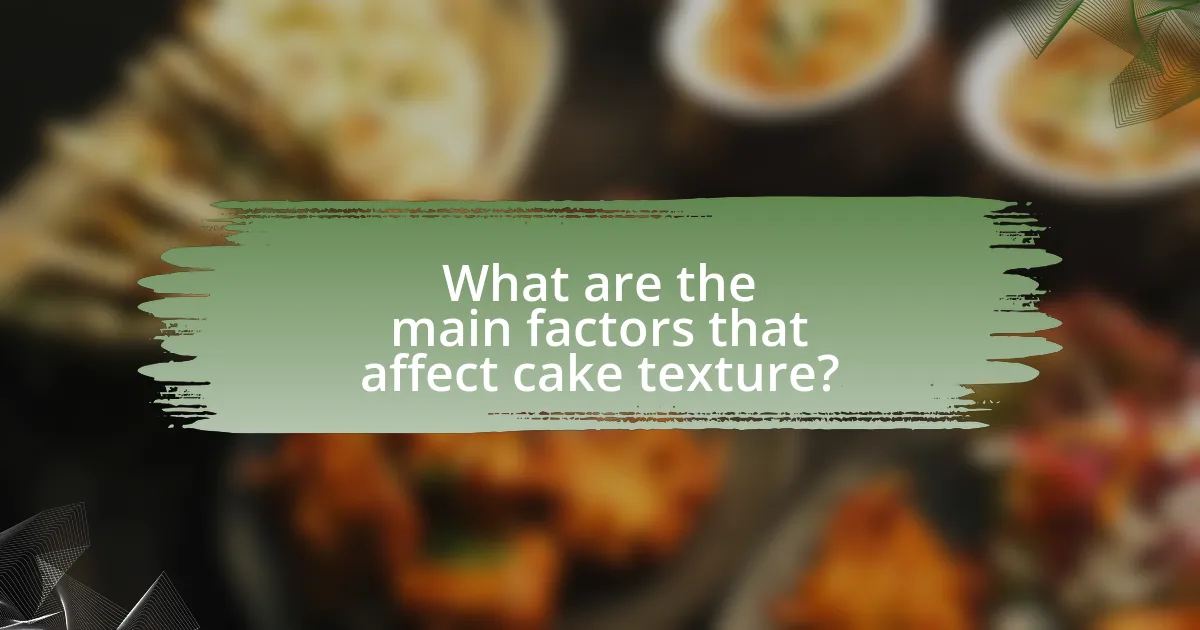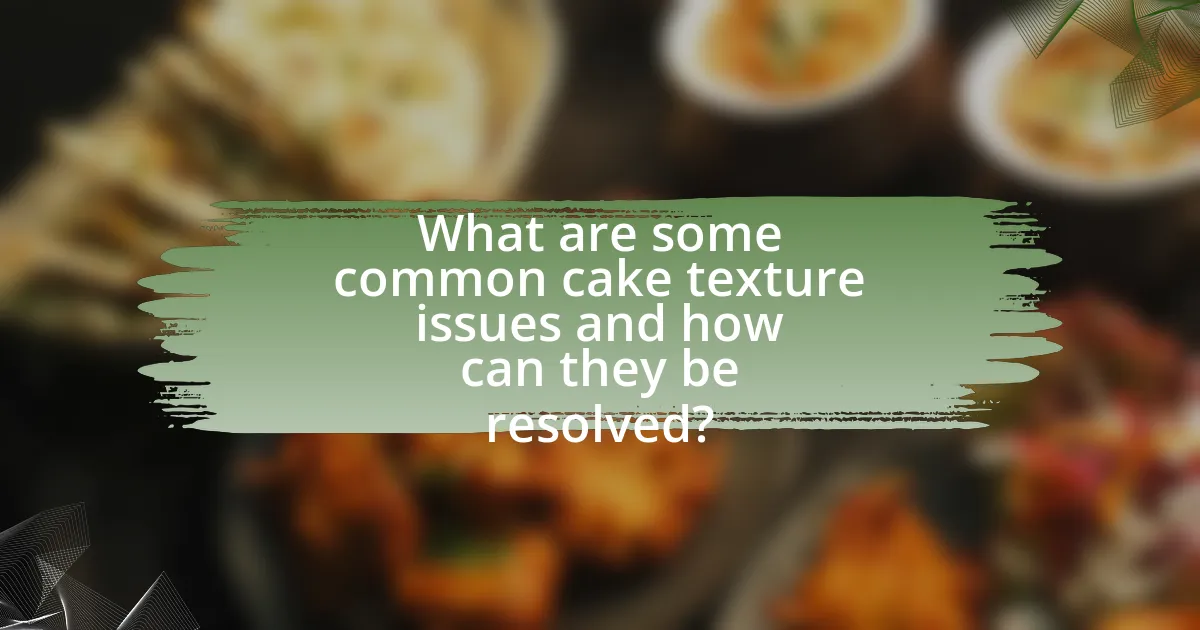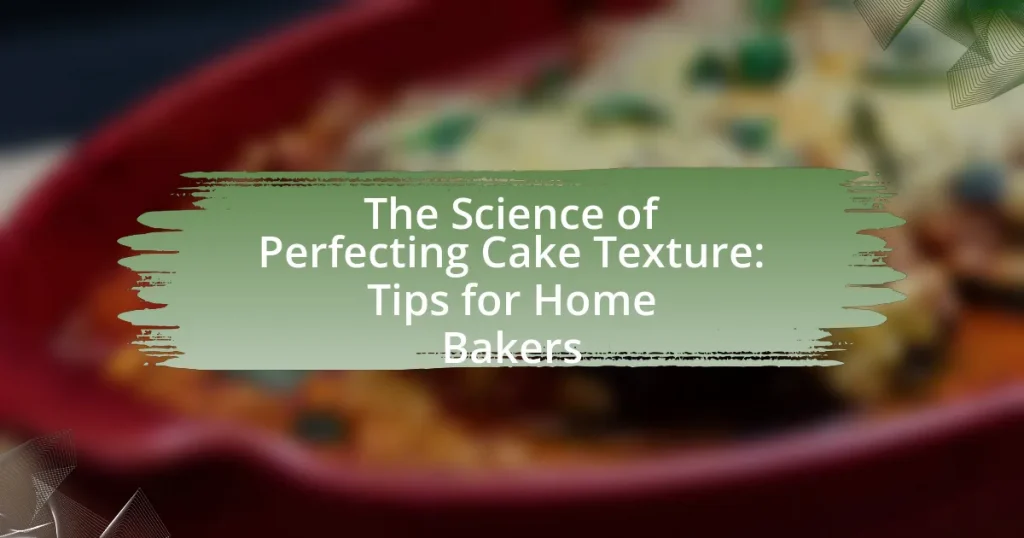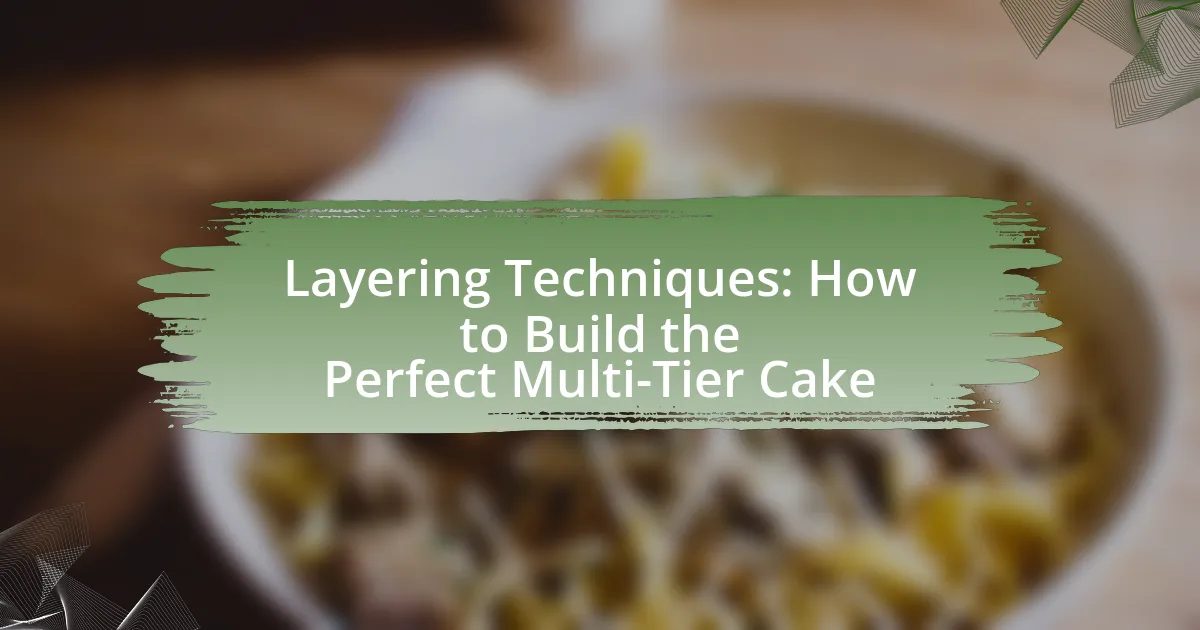The article focuses on the science of cake texture, detailing how ingredients, mixing methods, and baking conditions influence the final product’s structure and mouthfeel. It highlights the importance of key components such as flour, sugar, and fats, and discusses how proper mixing techniques and baking temperatures can achieve desired textures. Additionally, the article addresses common mistakes made by home bakers, the impact of texture on flavor perception, and offers practical tips for troubleshooting texture issues. By understanding these principles, bakers can enhance their skills and consistently produce high-quality cakes.

What is the Science of Cake Texture?
The science of cake texture involves the interplay of ingredients, mixing methods, and baking conditions that influence the final product’s structure and mouthfeel. Key components include flour, which provides gluten that contributes to elasticity; sugar, which affects moisture retention and tenderness; and fats, which create a tender crumb by coating flour proteins. The mixing process also plays a crucial role; overmixing can lead to a dense cake due to excessive gluten development, while undermixing may result in a crumbly texture. Additionally, the baking temperature and time impact moisture evaporation and the formation of a crust, further defining the cake’s texture. Understanding these factors allows bakers to manipulate ingredients and techniques to achieve desired textures, such as light and airy or dense and moist cakes.
How does cake texture impact the overall baking experience?
Cake texture significantly impacts the overall baking experience by influencing both the sensory qualities and the success of the baking process. A well-textured cake, whether it is light and airy or dense and moist, affects how bakers perceive their skills and the enjoyment of the final product. For instance, a cake that is too dry or crumbly can lead to disappointment, while a perfectly textured cake enhances satisfaction and encourages further baking endeavors. Research indicates that texture is a critical factor in consumer preference, with studies showing that cakes with a desirable crumb structure are more likely to be rated favorably by tasters. This highlights the importance of mastering techniques that contribute to optimal cake texture, such as proper mixing methods and ingredient ratios, ultimately enriching the baking experience.
What are the key characteristics of perfect cake texture?
The key characteristics of perfect cake texture include a light and airy crumb, moisture retention, and a balanced density. A light and airy crumb is achieved through proper aeration during mixing, which incorporates air into the batter, resulting in a fluffy structure. Moisture retention is crucial for preventing dryness, often accomplished by using ingredients like eggs and fats, which contribute to a tender texture. Balanced density ensures that the cake is neither too heavy nor too crumbly, typically achieved by accurately measuring ingredients and following the correct mixing techniques. These characteristics are essential for creating a cake that is enjoyable in both flavor and mouthfeel.
How does texture influence flavor perception in cakes?
Texture significantly influences flavor perception in cakes by affecting how taste and aroma compounds are released and experienced. The mouthfeel of a cake, whether it is moist, crumbly, or dense, alters the sensory experience, impacting how flavors are perceived. For instance, a moist cake can enhance sweetness and richness, while a dry cake may lead to a muted flavor experience. Research indicates that texture can modify the release of volatile compounds, which are crucial for flavor perception, as demonstrated in studies that show a correlation between texture and the intensity of flavor experienced by tasters. Thus, the interplay between texture and flavor perception is essential for creating an enjoyable cake.
Why is understanding cake texture important for home bakers?
Understanding cake texture is crucial for home bakers because it directly influences the quality and enjoyment of the final product. The texture of a cake affects its moisture, crumb structure, and overall mouthfeel, which are essential for achieving a desirable eating experience. For instance, a well-aerated cake will be light and fluffy, while a denser cake may be perceived as heavy or dry. Knowledge of how ingredients like flour, sugar, and fats interact during mixing and baking allows bakers to manipulate these factors to create the desired texture. Research indicates that the balance of these ingredients can significantly alter the cake’s final characteristics, making it essential for bakers to understand the science behind texture to consistently produce high-quality cakes.
What common mistakes do home bakers make regarding cake texture?
Home bakers commonly make mistakes such as overmixing the batter, which leads to a dense and tough cake texture. Overmixing incorporates too much air and develops gluten, negatively affecting the cake’s lightness. Additionally, using incorrect ingredient temperatures, like cold eggs or butter, can result in uneven mixing and a poor rise. Not measuring ingredients accurately can also lead to imbalances, affecting the cake’s structure and moisture content. Lastly, failing to properly preheat the oven can cause uneven baking, resulting in a cake that is either undercooked or overcooked in certain areas.
How can mastering cake texture improve baking skills?
Mastering cake texture significantly enhances baking skills by enabling bakers to create cakes that are consistently moist, tender, and flavorful. Understanding the science behind ingredients and techniques, such as the role of flour types, sugar, and fat, allows bakers to manipulate texture effectively. For instance, using cake flour instead of all-purpose flour results in a finer crumb, while incorporating the right amount of air during mixing can lead to a lighter cake. Research indicates that texture is a critical factor in consumer preference, with studies showing that cakes with optimal texture are rated higher in taste tests. Therefore, mastering cake texture not only improves the quality of baked goods but also increases a baker’s confidence and creativity in the kitchen.

What are the main factors that affect cake texture?
The main factors that affect cake texture include the type of flour used, the ratio of ingredients, mixing method, and baking temperature. The type of flour determines the protein content, which influences gluten formation; for example, cake flour has lower protein than all-purpose flour, resulting in a softer texture. The ratio of ingredients, particularly the balance of fat, sugar, and liquid, affects moisture and tenderness; a higher fat content typically yields a richer, softer cake. The mixing method impacts air incorporation and gluten development; overmixing can lead to a denser texture, while undermixing may result in a crumbly cake. Finally, baking temperature affects the rate of rise and moisture retention; baking at too high a temperature can cause a dry crust, while too low can lead to insufficient rise.
How do ingredients influence cake texture?
Ingredients significantly influence cake texture through their chemical properties and interactions during the baking process. For example, flour provides structure due to its gluten-forming proteins, while fats like butter create tenderness by coating flour particles and inhibiting gluten development. Sugar not only sweetens but also contributes to moisture retention and aeration, leading to a lighter texture. Additionally, eggs act as emulsifiers, binding ingredients and adding richness, which enhances the overall mouthfeel. The balance and combination of these ingredients determine whether a cake is light and airy or dense and moist, as evidenced by the varying textures found in different cake recipes.
What role do flour types play in cake texture?
Flour types significantly influence cake texture due to their varying protein content and gluten-forming potential. For instance, cake flour, which has a low protein content (around 7-9%), produces a tender and soft crumb, ideal for light cakes. In contrast, all-purpose flour, with a moderate protein content (about 10-12%), offers a balance that can yield a denser texture suitable for a variety of cakes. Bread flour, containing higher protein levels (approximately 12-14%), creates a chewier texture, which is generally not desirable for cakes but can be used in specific recipes for added structure. The protein content directly affects gluten development; more gluten results in a firmer texture, while less gluten leads to a more delicate crumb. This relationship between flour type and cake texture is crucial for achieving the desired outcome in baking.
How do fats and sugars contribute to the texture of cakes?
Fats and sugars significantly influence the texture of cakes by providing moisture, tenderness, and structure. Fats, such as butter or oil, create a tender crumb by coating flour proteins, which inhibits gluten formation and results in a softer texture. Additionally, fats contribute to the cake’s richness and mouthfeel. Sugars, on the other hand, not only sweeten but also retain moisture and create a light, airy structure through the process of creaming, where sugar is beaten with fat to incorporate air. This aeration is crucial for achieving a fluffy texture. Together, the combination of fats and sugars ensures a balanced cake that is both moist and tender, enhancing the overall eating experience.
What techniques can be used to achieve the desired cake texture?
To achieve the desired cake texture, techniques such as proper ingredient measurement, accurate mixing methods, and appropriate baking temperatures are essential. Accurate measurement ensures the correct balance of dry and wet ingredients, which affects the cake’s density and moisture. Mixing methods, like creaming butter and sugar, incorporate air into the batter, leading to a lighter texture. Additionally, baking at the right temperature allows for even cooking, preventing a dry or overly dense cake. These techniques are supported by baking science, which emphasizes the importance of ingredient interactions and heat application in achieving optimal cake texture.
How does mixing method affect cake texture?
Mixing method significantly affects cake texture by influencing the incorporation of air and the development of gluten. For instance, the creaming method, which involves beating butter and sugar together, creates a light and airy texture due to the incorporation of air bubbles. In contrast, the muffin method, which combines wet and dry ingredients without extensive mixing, results in a denser, more tender cake because it minimizes gluten development. Research indicates that overmixing can lead to a tough texture due to excessive gluten formation, while undermixing can result in a crumbly structure. Therefore, the choice of mixing method directly determines the final texture of the cake.
What baking temperatures are ideal for different cake textures?
Baking temperatures ideal for different cake textures vary significantly. For a light and airy texture, such as in sponge cakes, a temperature of 350°F (175°C) is optimal, allowing for even rising without burning. In contrast, denser cakes like pound cakes benefit from a lower temperature of 325°F (160°C), which ensures thorough cooking without excessive browning. For cakes requiring a moist crumb, such as chocolate cakes, a temperature of 350°F (175°C) is also effective, as it promotes a rich texture while preventing dryness. These temperature guidelines are supported by baking science, which indicates that the Maillard reaction and caramelization occur optimally within these ranges, influencing the final texture and flavor of the cake.

What are some common cake texture issues and how can they be resolved?
Common cake texture issues include dryness, density, and crumbliness, each of which can be resolved through specific adjustments. Dryness often results from overbaking or insufficient fat; to resolve this, bakers should monitor baking times closely and ensure adequate fat content, such as butter or oil, is used. Density typically arises from overmixing or using too much flour; this can be corrected by mixing just until ingredients are combined and measuring flour accurately, ideally by weight. Crumbliness is often due to insufficient binding agents or too much sugar; increasing the amount of eggs or reducing sugar can help achieve a more cohesive texture. These solutions are supported by baking science, which emphasizes the importance of ingredient ratios and mixing techniques in achieving the desired cake texture.
What causes cakes to be too dense or too dry?
Cakes become too dense or too dry primarily due to improper ingredient ratios and mixing techniques. When too much flour is used relative to liquid, or when the batter is overmixed, the cake can develop a dense texture. Conversely, insufficient moisture or overbaking can lead to dryness. For instance, a cake recipe that calls for one cup of flour but uses one and a quarter cups will likely result in a denser cake. Additionally, mixing the batter excessively incorporates too much air, which can cause the cake to collapse and become dense. Properly measuring ingredients and following mixing instructions are crucial for achieving the desired cake texture.
How can ingredient adjustments prevent dense cakes?
Ingredient adjustments can prevent dense cakes by modifying the ratios of flour, fat, and liquid. Reducing the amount of flour or increasing the liquid can create a lighter batter, while using cake flour instead of all-purpose flour decreases protein content, resulting in a softer texture. Additionally, incorporating more air into the batter through techniques like creaming butter and sugar or using whipped egg whites can enhance the cake’s lightness. Studies show that cakes made with higher liquid content and lower flour ratios yield a more tender crumb, supporting the effectiveness of these adjustments in achieving the desired cake texture.
What baking techniques can help avoid dry cakes?
To avoid dry cakes, bakers should utilize techniques such as measuring ingredients accurately, incorporating fats properly, and ensuring the correct baking time and temperature. Accurate measurement of flour and sugar prevents excess dryness; for instance, using a kitchen scale can yield precise amounts, which is crucial since too much flour can lead to a dense texture. Proper incorporation of fats, like butter or oil, adds moisture and richness; creaming butter and sugar together until light and fluffy introduces air, enhancing the cake’s texture. Additionally, monitoring baking time and temperature is essential; overbaking can lead to moisture loss, so using a toothpick to check for doneness ensures the cake remains moist. These techniques are supported by baking science, which emphasizes the importance of ingredient ratios and baking conditions in achieving optimal cake texture.
How can home bakers troubleshoot texture problems effectively?
Home bakers can troubleshoot texture problems effectively by analyzing the ingredients, mixing methods, and baking conditions. For instance, if a cake is too dense, it may be due to overmixing the batter, which develops gluten and leads to a heavy texture. Conversely, if a cake is too crumbly, insufficient mixing or not enough binding agents like eggs can be the cause. Additionally, using the correct flour type is crucial; all-purpose flour can yield different results compared to cake flour, which has lower protein content and produces a lighter texture. Monitoring oven temperature is also essential, as baking at too high a temperature can cause the cake to rise rapidly and then collapse, resulting in an undesirable texture. These troubleshooting methods are supported by baking science, which emphasizes the importance of ingredient ratios and techniques in achieving the desired cake texture.
What are the signs of overmixing and how can it be avoided?
The signs of overmixing include a dense and tough cake texture, a gummy or rubbery crumb, and the presence of large air bubbles in the batter. Overmixing occurs when the flour’s gluten is excessively developed, leading to these undesirable characteristics. To avoid overmixing, bakers should mix ingredients just until they are combined, using gentle folding techniques rather than vigorous stirring. Additionally, using a timer can help ensure that mixing does not exceed the recommended duration, typically around 2-3 minutes for most cake batters.
How can bakers test for doneness to ensure optimal texture?
Bakers can test for doneness by using a toothpick or cake tester inserted into the center of the cake; if it comes out clean or with a few moist crumbs, the cake is done. This method is effective because it directly assesses the internal structure of the cake, ensuring that it has set properly and achieved the desired texture. Additionally, bakers can observe the cake’s edges pulling away from the pan and a golden-brown color on the surface, which are indicators of doneness. These techniques are widely recognized in baking practices, confirming their reliability in achieving optimal cake texture.
What are the best practices for perfecting cake texture at home?
To perfect cake texture at home, use the right ingredients, measure accurately, and follow proper mixing techniques. High-quality ingredients, such as fresh flour and eggs, contribute to a better texture. Accurate measurement ensures the correct balance of dry and wet ingredients, which is crucial for achieving the desired consistency. Mixing techniques, such as creaming butter and sugar until light and fluffy, incorporate air into the batter, resulting in a lighter cake. Additionally, baking at the correct temperature and avoiding overmixing are essential practices that prevent dense or dry cakes. These methods are supported by baking science, which emphasizes the importance of ingredient interaction and proper technique in achieving optimal cake texture.
How can ingredient temperature affect cake texture?
Ingredient temperature significantly affects cake texture by influencing the way ingredients interact during mixing and baking. For instance, using room temperature butter and eggs allows for better incorporation of air, resulting in a lighter and fluffier cake. Conversely, cold ingredients can lead to a denser texture because they do not emulsify properly, preventing the formation of a stable batter. Research indicates that cakes made with room temperature ingredients rise more effectively due to improved aeration and moisture distribution, which are critical for achieving the desired texture.
What tips can help ensure consistent results in cake baking?
To ensure consistent results in cake baking, it is essential to accurately measure ingredients. Precise measurements of flour, sugar, and liquids directly impact the cake’s texture and flavor. For instance, using a kitchen scale to measure flour can prevent variations caused by packing, which can lead to dry or dense cakes. Additionally, maintaining consistent oven temperature is crucial; using an oven thermometer can help verify that the temperature is accurate, as even slight deviations can affect baking times and outcomes. Lastly, following the recipe’s order of operations, such as creaming butter and sugar before adding eggs, ensures proper incorporation of air, contributing to a light and fluffy texture.




